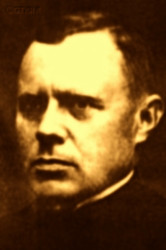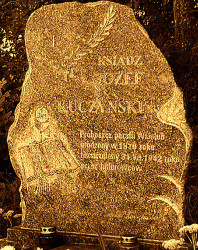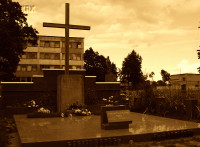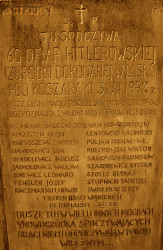Roman Catholic
St Sigismund parish
05-507 Słomczyn
85 Wiślana Str.
Konstancin deanery
Warsaw archdiocese, Poland
full list:
displayClick to display full list

searchClick to search full list by categories
wyświetlKliknij by wyświetlić pełną listę po polsku

szukajKliknij by przeszukać listę wg kategorii po polsku

Martyrology of the clergy — Poland
XX century (1914 – 1989)
personal data
surname
KUCZYŃSKI
forename(s)
Joseph (pl. Józef)
function
diocesan priest
creed
Latin (Roman Catholic) Church RCmore on
en.wikipedia.org
[access: 2014.09.21]
diocese / province
Pinsk diocesemore on
en.wikipedia.org
[access: 2013.05.19]
Vilnius diocesemore on
en.wikipedia.org
[access: 2013.05.19]
RC Military Ordinariate of Polandmore on
en.wikipedia.org
[access: 2014.12.20]
academic distinctions
Doctor of Sacred Theology
date and place
of death
31.07.1942

Skridlevotoday: Koshelevo ssov., Navahrudak dist., Grodno reg., Belarus
more on
ru.wikipedia.org
[access: 2023.01.18]
details of death
In 1909 accused by the Russians of organizing a secret Polish school for the first time and sentenced to a fine.
In 1910, again for organizing a secret Polish school, deprived by the Russians, who were then occupying — during the partitions of Poland — the territories of Belarus of the right to hold the position of parish priest.
In the years 1919‐1921, during the Polish–Russian War of 1919‐1921, volunteer chaplain of the Polish Army. In the summer of 1920, during the Russian offensive, which threatened the Polish state, became chaplain of the Siberian Infantry Brigade, formed starting from 14.07.1920 in Pomerania (i.a. in Grupa near Grudziądz and Toruń), among others from the remnants of the 5th Polish Rifle Division, formed in 1919 in Siberia, from among Poles working there and children and grandchildren of exiles and deportees, which capitulated to the Bolsheviks, although some soldiers managed to return to the Poland. In the first decade of 08.1920, the brigade was sent to Zegrze, to the front, and subordinated to the 5th Army, under the command of Gen. Vladislav Sikorski. From 14.08.1920, the brigade fought at Borkowo, then during the the Wkra Battle at Nasielsk, Prusinowice. It captured Maków. It fought a dramatic battle with the Russians at Przasnysz, Chorzele and Myszyniec (23.08.1920), about which Gen. Lucien Żeligowski recalled the fate of some of the soldiers captured by the Russians as follows: „The view of the battlefield was unpleasant impression. There was a large number of corpses. They were mostly our soldiers, but not so much wounded and killed during the fighting, as killed after the fight. Entire rows of corpses, in underwear only and without shoes, lay along the fences and in the nearby bushes. They were stabbed with sabres and bayonets, their faces were mangled and their eyes were gouged out”. The heavy fighting — the brigade's losses amounted to 50% of its personnel — contributed significantly to the triumph of the Polish arms in the Battle of Warsaw (known as the „Miracle on the Vistula”), which began on c. 15.08.1920, thanks to the outflanking of the Russian troops by the so‐called offensive from the Wieprz River.
In 1923, 1924, 1925, 1927 and 1929 appointed reserve chaplain of the Polish Army (from 25.11.1926 each time for a statutory 2‐year period).
After German and Russian invasion of Poland in 09.1939 and start of the World War II, after German attack on 22.06.1941 of their erstwhile ally, Russians, and start of German occupation, was to „save many Jews from death”, according to some testimonies — the local Jews in Vselyub, where was a parish priest, were in the spring of 1942 transported by the Germans to the ghetto in Navahrudak, and then on 07.08.1942, c. 5,500 of the gathered there were murdered.
Arrested by the Germans on 29.06.1942 (as part of larger «Polenaktion» extermination plan of local Poles).
Jailed in Navahrudak prison.
Executed in the forest by Navahrudak, by the military barracks, for helping and hiding Jewish children (together with father Michael Dalecki and c. 60 Poles from Navahrudak and vicinity).
cause of death
mass murder
perpetrators
Germans
sites and events
«Polenaktion» 1942Click to display the description, Help to the JewsClick to display the description, Ribbentrop‐MolotovClick to display the description, Pius XI's encyclicalsClick to display the description, Polish‐Russian war of 1919‐1921Click to display the description
date and place
of birth
01.11.1879

n. Švenčionystoday: Švenčionys eld., Švenčionys dist., Vilnius Cou., Lithuania
more on
en.wikipedia.org
[access: 2020.11.13]
presbyter (holy orders)
ordination
28.10.1903

Vilniustoday: Vilnius city dist., Vilnius Cou., Lithuania
more on
en.wikipedia.org
[access: 2022.01.06]
positions held
1933 – 1942
parish priest — Vselyubtoday: Vselyub ssov., Navahrudak dist., Grodno reg., Belarus
more on
en.wikipedia.org
[access: 2023.01.13] ⋄ St Casimir RC parish ⋄ Navahrudaktoday: Navahrudak dist., Grodno reg., Belarus
more on
en.wikipedia.org
[access: 2021.07.04] RC deanery
1920 – 1933
dean — Kobryntoday: Kobryn dist., Brest reg., Belarus
more on
en.wikipedia.org
[access: 2021.12.18] RC deanery
1920 – 1933
parish priest — Kobryntoday: Kobryn dist., Brest reg., Belarus
more on
en.wikipedia.org
[access: 2021.12.18] ⋄ Assumption of the Blessed Virgin Mary RC parish ⋄ Kobryntoday: Kobryn dist., Brest reg., Belarus
more on
en.wikipedia.org
[access: 2021.12.18] RC deanery
1919 – 1921
RC military chaplain — Siberian Brigade, Polish Armed Forces — from c. 14.07.1920 chaplain of the Siberian Infantry Brigade; in 1921 of the Siberian Infantry Division (30th Polesian Infantry Division), formed by order of 20.12.1920 on the basis of the Siberian Infantry Brigade; in 1921 demobilised and transferred to the reserves of the Polish Army, verified as the chaplain of the Polish Army, with seniority from 01.06.1919, in the rank of captain
PhD student — Fribourgtoday: Fribourg can., Switzerland
more on
en.wikipedia.org
[access: 2021.07.25] ⋄ philosophy, Lat. Universitas Friburgensis (Eng. University of Fribourg) — studies crowned with a Sacred Theology PhD Doctor’ degree
1910
resident — Lidatoday: Lida dist., Grodno reg., Belarus
more on
en.wikipedia.org
[access: 2021.09.29] ⋄ Exaltation of the Holy Cross RC parish (main parish) ⋄ Lidatoday: Lida dist., Grodno reg., Belarus
more on
en.wikipedia.org
[access: 2021.09.29] RC deanery
1909 – 1910
priest — Dzyatlavatoday: Dzyatlava dist., Grodno reg., Belarus
more on
en.wikipedia.org
[access: 2022.01.06] ⋄ Assumption of the Blessed Virgin Mary RC parish ⋄ Slonimtoday: Slonim dist., Grodno reg., Belarus
more on
en.wikipedia.org
[access: 2021.09.29] RC deanery
1905 – 1909
curatus/rector/expositus — Pareččatoday: Parečča ssov., Grodno dist., Grodno reg., Belarus
more on
be.wikipedia.org
[access: 2023.01.18] ⋄ Our Lady of Perpetual Help RC church ⋄ Grodnotoday: Grodno dist., Grodno reg., Belarus
more on
en.wikipedia.org
[access: 2023.01.18], St Francis Xavier RC parish (main parish) ⋄ Grodnotoday: Grodno dist., Grodno reg., Belarus
more on
en.wikipedia.org
[access: 2023.01.18] RC deanery
1904 – 1905
vicar — Dąbrowa Grodzieńskatoday: Dąbrowa Białostocka, Dąbrowa Białostocka gm., Sokółka pov., Podlaskie voiv., Poland
more on
en.wikipedia.org
[access: 2021.09.29] ⋄ St Stanislav the Bishop and Martyr and St Anthony of Padua RC parish ⋄ Sokółkatoday: Sokółka gm., Sokółka pov., Podlaskie voiv., Poland
more on
en.wikipedia.org
[access: 2021.09.29] RC deanery
till 1903
student — Vilniustoday: Vilnius city dist., Vilnius Cou., Lithuania
more on
en.wikipedia.org
[access: 2022.01.06] ⋄ philosophy and theology, Theological Seminary
others related
in death
DALECKIClick to display biography Michael
sites and events
descriptions
«Polenaktion» 1942: In the summer of 1942 in German‐occupied Germ. Generalbezirk Weißruthenien (Eng. General Region of Belarus) — in Nowogródek region among others — Germans carried out «Polenaktion» initiative: the name introduced in a special resolution drafted by Reichssicherheitshauptamt RSHA (Eng. Reich Main Security Office). The action included sacking of all Poles from civilian regional apparatus and police and replacing them with Belarusians. Thousands of Poles were also forcibly deported to Germany as slave labourers. On 26‐30.06.1942 in all counties of the region more than 1,000 representatives of Polish intelligentsia were arrested and subsequently murdered. In Lida region 16 Polish priests were arrested among others. 5 Polish parish priests from Hlybokaye and Pastavy deanery were murdered as well. At the same time Germans set up KL Koldichevo concentration camp n. Baranavichy. The implementation of this genocide project was entrusted to Belarusian collaborationist formations, political, administrative — responsible for preparation of proscription lists — and police, i.e. niem. Weißruthenische Hilfspolizei (Eng. Belarusian Auxiliary Police), supported by Ukrainian, Lithuanian, Latvian and Russian (RONA) collaborators. The action was coordinated with the liquidation of the Jewish ghettos in the Germ. Generalbezirk Weißruthenien.
Help to the Jews: During World War II on the Polish occupied territories Germans forbid to give any support to the Jews under penalty of death. Hundreds of Polish priests and religious helped the Jews despite this official sanction. Many of them were caught and murdered.
Ribbentrop‐Molotov: Genocidal Russian‐German alliance pact between Russian leader Joseph Stalin and German leader Adolf Hitler signed on 23.08.1939 in Moscow by respective foreign ministers, Mr. Vyacheslav Molotov for Russia and Joachim von Ribbentrop for Germany. The pact sanctioned and was the direct cause of joint Russian and German invasion of Poland and the outbreak of the World War II in 09.1939. In a political sense, the pact was an attempt to restore the status quo ante before 1914, with one exception, namely the „commercial” exchange of the so‐called „Kingdom of Poland”, which in 1914 was part of the Russian Empire, fore Eastern Galicia (today's western Ukraine), in 1914 belonging to the Austro‐Hungarian Empire. Galicia, including Lviv, was to be taken over by the Russians, the „Kingdom of Poland” — under the name of the General Governorate — Germany. The resultant „war was one of the greatest calamities and dramas of humanity in history, for two atheistic and anti‐Christian ideologies — national and international socialism — rejected God and His fifth Decalogue commandment: Thou shall not kill!” (Abp Stanislav Gądecki, 01.09.2019). The decisions taken — backed up by the betrayal of the formal allies of Poland, France and Germany, which on 12.09.1939, at a joint conference in Abbeville, decided not to provide aid to attacked Poland and not to take military action against Germany (a clear breach of treaty obligations with Poland) — were on 28.09.1939 slightly altered and made more precise when a treaty on „German‐Russian boundaries and friendship” was agreed by the same murderous signatories. One of its findings was establishment of spheres of influence in Central and Eastern Europe and in consequence IV partition of Poland. In one of its secret annexes agreed, that: „the Signatories will not tolerate on its respective territories any Polish propaganda that affects the territory of the other Side. On their respective territories they will suppress all such propaganda and inform each other of the measures taken to accomplish it”. The agreements resulted in a series of meeting between two genocidal organization representing both sides — German Gestapo and Russian NKVD when coordination of efforts to exterminate Polish intelligentsia and Polish leading classes (in Germany called «Intelligenzaktion», in Russia took the form of Katyń massacres) where discussed. Resulted in deaths of hundreds of thousands of Polish intelligentsia, including thousands of priests presented here, and tens of millions of ordinary people,. The results of this Russian‐German pact lasted till 1989 and are still in evidence even today. (more on: en.wikipedia.orgClick to attempt to display webpage
[access: 2015.09.30])
Pius XI's encyclicals: Facing the creation of two totalitarian systems in Europe, which seemed to compete with each other, though there were more similarities than contradictions between them, Pope Pius XI issued in 03.1937 (within 5 days) two encyclicals. In the „Mit brennender Sorge” (Eng. „With Burning Concern”) published on 14.03.1938, condemned the national socialism prevailing in Germany. The Pope wrote: „Whoever, following the old Germanic‐pre‐Christian beliefs, puts various impersonal fate in the place of a personal God, denies the wisdom of God and Providence […], whoever exalts earthly values: race or nation, or state, or state system, representatives of state power or other fundamental values of human society, […] and makes them the highest standard of all values, including religious ones, and idolizes them, this one […] is far from true faith in God and from a worldview corresponding to such faith”. On 19.03.1937, published „Divini Redemptoris” (Eng. „Divine Redeemer”), in which criticized Russian communism, dialectical materialism and the class struggle theory. The Pope wrote: „Communism deprives man of freedom, and therefore the spiritual basis of all life norms. It deprives the human person of all his dignity and any moral support with which he could resist the onslaught of blind passions […] This is the new gospel that Bolshevik and godless communism preaches as a message of salvation and redemption of humanity”… Pius XI demanded that the established human law be subjected to the natural law of God , recommended the implementation of the ideal of a Christian state and society, and called on Catholics to resist. Two years later, National Socialist Germany and Communist Russia came together and started World War II. (more on: www.vatican.vaClick to attempt to display webpage
[access: 2023.05.28], www.vatican.vaClick to attempt to display webpage
[access: 2023.05.28])
Polish‐Russian war of 1919‐1921: War for independence of Poland and its borders. Poland regained independence in 1918 but had to fight for its borders with former imperial powers, in particular Russia. Russia planned to incite Bolshevik‐like revolutions in the Western Europe and thus invaded Poland. Russian invaders were defeated in 08.1920 in a battle called Warsaw battle („Vistula river miracle”, one of the 10 most important battles in history, according to some historians). Thanks to this victory Poland recaptured part of the lands lost during partitions of Poland in XVIII century, and Europe was saved from the genocidal Communism. (more on: en.wikipedia.orgClick to attempt to display webpage
[access: 2014.12.20])
sources
personal:
www.glaukopis.plClick to attempt to display webpage
[access: 2012.11.23], www.stankiewicze.comClick to attempt to display webpage
[access: 2013.02.15], ordynariat.wp.mil.plClick to attempt to display webpage
[access: 2024.12.13], www.polacyizydzi.plClick to attempt to display webpage
[access: 2013.02.15]
bibliographical:
„Martyrology of the Polish Roman Catholic clergy under nazi occupation in 1939‐1945”, Victor Jacewicz, John Woś, vol. I‐V, Warsaw Theological Academy, 1977‐1981
„Pinsk Diocese in Poland Clergy and Church Register”, Pinsk diocese bishop, 1933‐1939, diocesan printing house
original images:
polacyratujacyzydow.plClick to attempt to display webpage
[access: 2015.09.30], www.flickr.comClick to attempt to display webpage
[access: 2013.12.04], www.flickr.comClick to attempt to display webpage
[access: 2014.05.09], www.flickr.comClick to attempt to display webpage
[access: 2014.05.09]
LETTER to CUSTODIAN/ADMINISTRATOR
If you have an Email client on your communicator/computer — such as Mozilla Thunderbird, Windows Mail or Microsoft Outlook, described at WikipediaPatrz:
en.wikipedia.org, among others — try the link below, please:
LETTER to CUSTODIAN/ADMINISTRATORClick and try to call your own Email client
If however you do not run such a client or the above link is not active please send an email to the Custodian/Administrator using your account — in your customary email/correspondence engine — at the following address:

giving the following as the subject:
MARTYROLOGY: KUCZYŃSKI Joseph
To return to the biography press below:
 Click to return to biography
Click to return to biography











